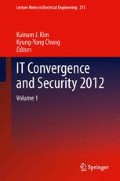Abstract
This paper proposes a secure and efficient one-way hash function based on a linear group and nonlinear non-group cellular automata (CA). The proposed architecture is based on parallelism and logical bitwise operation on CA so that our function forms remarkably simple structure. We show that the proposed one-way hash function based on a CA satisfies the secure properties and produces an excellent quality of message digest in spite of a low construction cost.
Access this chapter
Tax calculation will be finalised at checkout
Purchases are for personal use only
References
Rivest RL (1991) The MD4 message-digest algorithm. Crypto, LNCS 537:303–311
Daemen J, Govaerts R, Vandewalle J (1993) A framework for the design of one-way hash functions including cryptanalysis of Damgard’s one-way function based on a cellular automaton. Proc Asiacrypto’91, LNCS 739:82–96
Mihaljecvic M, Zheng Y, Imai H (1999) A family of fast dedicated one-way hash functions based on linear cellular automata over GF(q). IEICE Trans Fundam E82-A(1):40–47
Zheng Y, Pieprzyk J, Sebery J (1993) HAVAL—a one-way hashing algorithm with variable length of output. Auscrypt, LNCS 718:83–104
Wolfram S (1983) Statistical mechanics of cellular automata. Rev Modern Phys 55:601–644
Jeon JC, Yoo KY (2008) Montgomery exponent architecture based on programmable cellular automata. Math Comput Simul 79:1189–1196
Jeon JC (2010) Nonlinear and nongroup cellular automata chaining technique for cryptographic applications. Math Comput Modell 51:995–999
Damgarrd IB (1989) A Design Principle for Hash Functions. Crypto, LNCS 435:416–442
Knuth DE (1997) The art of computer programming, seminumerical algorithms, vol 2, 3rd edn. Addison-Wesley Longman Publishing Co., Inc., Reading
Gajski DD (1997) Principles of digital design. Prentice-Hall International Inc., Prentice Hall
Acknowledgments
This research was supported by Basic Science Research Program through the National Research Foundation of Korea(NRF) funded by the Ministry of Education, Science and Technology (2011-0014977).
Author information
Authors and Affiliations
Corresponding author
Editor information
Editors and Affiliations
Rights and permissions
Copyright information
© 2013 Springer Science+Business Media Dordrecht
About this paper
Cite this paper
Jeon, JC. (2013). One-Way Hash Function Based on Cellular Automata. In: Kim, K., Chung, KY. (eds) IT Convergence and Security 2012. Lecture Notes in Electrical Engineering, vol 215. Springer, Dordrecht. https://doi.org/10.1007/978-94-007-5860-5_3
Download citation
DOI: https://doi.org/10.1007/978-94-007-5860-5_3
Published:
Publisher Name: Springer, Dordrecht
Print ISBN: 978-94-007-5859-9
Online ISBN: 978-94-007-5860-5
eBook Packages: EngineeringEngineering (R0)

